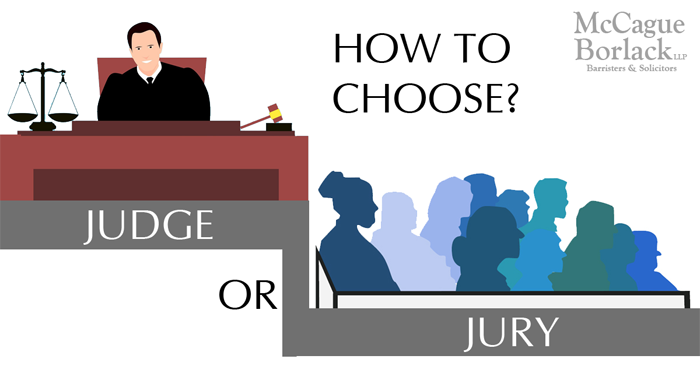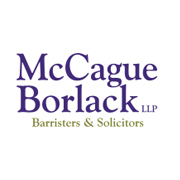By Van Krkachovski and Maxwell Gill
This paper was first presented at a client seminar.
During the COVID-19 pandemic, the courts were unable to hold jury trials for many civil claims, particularly MVA and tort cases. This ended in May 2022, and jury trials for civil cases have since resumed. During this time, many decisions proceeded before only a judge. This paper will outline the major differences between judge-alone and jury trials.
Statutory Deductible, Hidden by Statute
The Insurance Act requires that any award of damages against an insurer, under $138,343.86, is reduced by an amount established by statute, known as the "statutory deductible."1 This deductible increases every year, and, as of January 1, 2022, it is $41,503.50.2 Under this scheme, if a plaintiff is awarded $50,000 in an insurance claim, they only receive $8,496.50. There are a variety of rationales for this deductible, like a means to reduce frivolous claims,3 but they are beyond the scope of this paper. For our purposes, this value is important for one reason; most jurors do not know about it, and neither party is allowed to tell them.
The motivation for not informing the jury of the deductible is explained in a 2021 decision, Rumney v. Nelson.4 In this case, the plaintiff asked for an order that the jurors be advised of the statutory deductible. The plaintiff relied on the fact that the statute requires the jury to award damages without regard to the statutory deduction, and not necessarily without knowledge of it.5 The judge refused to grant this order. This is because, as stated by the judge, the role of the jury is to "decide liability, apportion liability if applicable, and assess damages without regard to the statutory deductible or other amounts that may be deducted."6 It is not the role of the jury to change their awards in order to reflect the plaintiff's perceived entitlement to certain amounts; they are intended to determine the liability and the damages that result from it.7 Once the damages are determined, it is the role of the judge to interpret the necessary legal framework and alter the awards if necessary.
This provides the strongest structural guarantee possible that any potential juror will not modify their award based on their knowledge of the statutory deductible, yet there is no similar guarantee for judges. Any jury award comes with the strongest structural guarantee that the amount awarded was not influenced by consideration of the deductible. When a jury awards $50,000, it is easy to believe they understood the plaintiff was entitled to $50,000. However, when a judge awards $50,000, there is no similar guarantee. Each party must take the judge at his word that the amount awarded was chosen "without regard to [the statutory deductible]."8
This is highly beneficial to defendants. Defense lawyers may claim the plaintiff is entitled to $30,000 or at most $40,000, and appear sympathetic to the jury, when they know the statutory deductible will reduce the claim to nothing. This benefit is even noted in case law, when, in the 2016 decision on Mandel v Fakhim,9 the judge noted:
"Jury trials in civil cases seem to exist in Ontario solely to keep damages awards low in the interest of insurance companies, rather than to facilitate injured parties being judged by their peers."10
...a jury trial does not guarantee low damages...
Despite these claims, a jury trial does not guarantee low damages, just like a judge-alone trial does not guarantee high damages. Rather, the focus should be on the structural safeguards in place to ensure one party does not account for the deductible in its determination, and the lack of an equivalent safeguard for judges.
Provision of Reasons for the Verdict
Another important distinction between judge-alone decisions and jury trials is the requirement to draft a decision. When a judge makes a decision in a judge-alone trial, they are required to document how they came to this conclusion. With a jury, counsel for the plaintiff(s) and the defendant(s) will agree on a series of questions to be put to the jury, and the jury is only required to answer these questions. Their answers do not need to be validated in any manner.
If this is viewed from a structural standpoint, the judge's requirement for reasons, and the jury's lack thereof, can be seen as the counterbalance to the jury's ignorance of the deductible. However, this is not the case. The evidence of this is, in part, reflected in the quote noted above: if the judge's requirement to provide reasons was as structurally effective as the jury's ignorance, then it is far less likely that jury trials would be seen to exist solely to keep damage awards low.
A consequence of this distinction, effective or not, is that it influences how a judge and jury reach a decision. Whether a judge determines the amount they wish to award and works backwards or determines liability and then the associated damages, there needs to be a set of reasons for the decision, based in fact and law, associated with that determination. With a jury, it is the exact opposite. The jury could award a large sum to a plaintiff solely because they feel sympathetic for the individual, even though they are expressly instructed not to let their sympathies influence their decision. They are instructed to base their damages award strictly on the evidence. Similarly, the jury could provide the plaintiff nothing, because they simply do not like the person and do not believe they deserve it, even though they are instructed not to be influenced by their personal opinions. Either way, no explanation is necessary. This provides the jury with a latitude not awarded to judges in judge-alone decisions; the ability to decide any case based on their common sense, gut feelings, and, although instructed to the contrary, their personal opinions about the parties involved, or even concerns about their insurance premiums.11
Legal Comprehension and Perspectives of the Parties
...(jurors) may make decisions or awards without a basis in law. |
A jury or judge is supposed to make determinations based on the applicable laws and jurisprudence, in conjunction with the facts of the case. However, it is commonly believed that juries approach a case with the life experience of six individuals, while a judge brings the legal experience of one individual. This has three implications; the first, outlined above when discussing the jury not requiring reasons, is that they may make decisions or awards without a basis in law.
The second implication is that the jury is in a weaker position to filter through misstatements and misrepresentations of the parties. This was demonstrated in a recent case, Braks v. Dundeal.12 In this case, the judge discharged the jury and continued the claim in a judge-alone trial because the defense counsel made repeated "misstatement[s] of evidence or [sic] unfair representation[s] of the evidence"13 in their closing. In at least one case the unfair representation was the Defense Counsel misinforming the jury on the law of contributory negligence.14 The judge had sufficient knowledge of the law to understand that the defense counsel was doing so, and thereby could react accordingly. The jury, lacking this knowledge, could have thereby been influenced by these misrepresentations.
The third implication is the extent to which jurors will comprehend complex legal theories, such as crumbling skull versus thin skull cases. These are complex and nuanced legal theories, that are difficult to express to a jury so that they sufficiently understand the relative differences. However, a judge will be intimately familiar with the differences between the two theories. Thus, the legal comprehension the judge will bring to bear on the case may have a better impact than the jury's varied life experience.
Personal Experience and the Analysis of Experts
Another difference between judge-alone and jury trials is the experience each group brings to bear on a case; specifically, past experience with expert witnesses. Most jurors have never seen or interacted with an expert witness beyond watching them appear in their favourite courtroom TV drama. A judge, on the other hand, has an abundance of experience with expert witnesses, and likely has either interacted with the expert witness on a prior case or heard about the expert witness from colleagues in the legal field or recent decisions.
This means two different groups, a judge and a jury, can have vastly different opinions on the exact same expert testimony. A jury will likely focus on the facts and opinion of the expert, and how credible they appear. Of course, a judge will pay attention to the same information, but this passes through extra filters; two of the most important being knowledge of this witness, and knowledge of alternate testimonies. If an expert is plaintiff-biased, a judge will likely be aware of that to some degree, due to the expert's past testimony, and this may be a factor when the judge weighs their evidence. Similarly, if the expert writes a shorter report than normal, the report appears more boilerplate, or the judge deems their answers to the questions posed to be of lower quality than those the judge is used to, this could be a factor when weighing the evidence.15 These are things the average juror is not exposed to; the default lens for a judge is one the average juror might not know exists. For jurors, the weight of the expert is derived at trial, because that is all they know; for judges, the weight of an expert could be derived from all the expert's testimony at trial, in conjunction with their prior knowledge of the expert and their prior experiences with other expert witnesses.
Limitations on Instructions
Jurors are not always the most attentive individuals... |
While jury instructions16 provide an opportunity for judges to direct the jury's focus to a specific legal test or correct a misstatement by either party, these instructions can have a limited impact. Jurors are not always the most attentive individuals, and once something has been said, it cannot be unsaid. While judges can use their jury instructions to rectify any misstatements or false representations by counsel, when these misstatements happen too often or are too egregious, the judge may be left with no option but to declare a mistrial or continue the trial judge-alone. This is highlighted in a recent case where the defense counsel made so many misrepresentations that the judge had no choice but to declare the trial continue before her alone.17 This entails increased time and, of course, increased costs for all parties.
Counsel Represents the Party
Another consideration for judge-alone or a jury trial is that there is a much greater burden on counsel, in terms of their manner, decorum, and appearance, to appear amenable to the jurors. Counsel, whether they desire to be or not, are often equated with their clients. The better counsel appears, the better the client looks. But, once counsel comes off as less than trustworthy, or as if they are not convinced in their own case, the jury will see that, and react accordingly. A good example of this would be objecting to questions. If plaintiff's counsel asks an improper question, and defense objects, the jury is asked to leave the room while counsel and the Judge deliberate. The jury is not told the result, but they do learn the answer when the respective individual does or does not answer the question. If one counsel objects too often and is consistently overruled, the jury may start wondering what they do not want the jury to know, or why they do not want the jury to know that information. On the other hand, where counsel asks too many questions where the objections are sustained, the jury may interpret this as counsel asking improper questions.
Final Considerations
There are a series of other considerations which must be mentioned but need not be elaborated on. Jury trials are often longer and more expensive than judge-alone trials. During jury selection, jurors often have no interest in participating, and may actively attempt to avoid being selected for the jury. This does make sense, as they are not paid very much:
- $0 from day 1-10;
- $40/day from day 11-49;
- $100 a day, from day 50+18
Also, trials can be disruptive to their everyday lives. This is, however, in contrast to our experience once the trial begins; at that point, jurors will quickly become engaged and take their responsibilities seriously. Furthermore, the jurors do not know that one party is represented by an insurance company (informing the jurors that one party was covered by insurance was sometimes sufficient to declare a mistrial),19 and therefore they may be inclined to award lower damages. There are also difficulties in considering how a judge or a jury will interpret the actions and testimony of witnesses. One case involved a plaintiff who, while on the witness stand, expressed "theatrical" presentations of pain, but the judge concluded that they were not inconsistent, unreliable or unreasonable in their testimony, and therefore accepted their evidence. It is hard to believe that most juries would accept such intended emphasis of their pain.
Moreover, jurors often have a different perception of evidence that is inconsistent with the plaintiff's testimony. For example, a jury may view surveillance, showing a certain level of activity, to be of significance, whereas a judge may not, even to the point of dismissing the evidence. The same is true for social media postings by the plaintiff where they engage in various activities inconsistent with their claimed injuries. In Pisani v. McDaniel, 2022 ONSC 224, a claim for damages resulting primarily from chronic pain, the judge essentially dismissed social media posts about the plaintiff going on a 5-kilometre hike as inconsistent with their claimed injuries. The judge in Graul v. Kansal, 2022 ONSC 1958, took a similar approach to surveillance video demonstrating the plaintiff engaged in yard work and other activities. One can only wonder if a jury would interpret this evidence in the same way.
Conclusion
The factors outlined above paint a mixed view of jurors and judge-alone trials, but it supports the general consensus that, in the majority of cases, a jury trial is more beneficial to the defendant than a judge-alone.
- 2022 Automobile Insurance Indexation Amounts Guidance
- Ibid.
- A Matter of Deductions: Resolving Uncertainty in MVA Litigation
- Rumney v. Nelson, 2021 ONSC 5632.
- Ibid at para 39.
- Ibid at para 45.
- This is contested. There are some individuals, often personal injury lawyers, who claim that juries cannot provide a just verdict or their will is being suppressed because they cannot evaluate a claim within the legal structures that the Insurance Act put in place. Their solution is to ban jury trials for civil claims, something that is already enforced in Quebec.
- Insurance Act, RSO 1990, c I.8 at s. 267.5(7).
- Mandel v Fakhim, 2016 ONSC 6538.
- Ibid at para 9.
- In Kapoor v Kuzmanovski, 2017 ONSC 1709, the plaintiff brought a motion to exclude potential jurors who drive and pay car insurance premiums, on the basis that these jurors "are inherently in a conflict of interest as they have a personal interest at stake adverse to a plaintiff." at para 3. The following decision, Kapoor v. Kuzmanovski, 2018 ONSC 4770, held, among other things, that there was "no clear and cogent evidence whatsoever that demonstrates a widespread bias." at para 140.
- Alison Braks v. Dundeal Canada (GP) Inc., 2022 ONSC 4015.
- Ibid at para 6.
- Ibid at para 128.
- In Legree v. Origlieri, 3032 ONSC 7650, the judge explicitly noted that they rely on Dr. Basile as more credible because the other doctor "Watson opined in areas that were beyond his area of expertise." Conversely, in Graul v. Kansal, 2022 ONSC 224, the experts were deemed less credible when their full opinion was only brought out on cross-examination. In Solanki v. Reilly, 2021 ONSC 6694, the Court refused expert testimony on the basis that the expert was acting too much like an advocate. A further example is Tarrington v. Havcare Investments Inc., 2021 ONSC 2175, where the judge made repeated references to different things the lawyers discussed, did not discuss, and should have discussed during the main and cross-examination of a witness. These factors considered by the judge are unlikely to be items at the front of a juror's mind when weighing the strength of different experts but would be prime considerations for a judge that has extensive experience with expert witnesses.
- Jury instructions refer to the moments during a trial where the judge guides the jury. The judge does this for a variety of reasons and on a variety of topics. The judge will often inform the jury of the applicable law, review the evidence with the jurors witness by witness, and sometimes tell them to ignore certain statements by either counsel, such as when the statement constitutes a misrepresentation of the evidence or is improper for another reason.
- Alison Braks v. Dundeal Canada (GP) Inc., 2022 ONSC 4015.
- Jury duty in Ontario - Serving as a juror
- Correia v. Jaycock, 2001 ABQB 503 at para 12.



